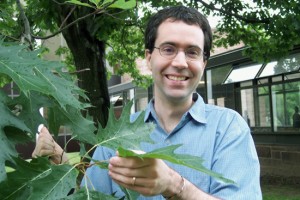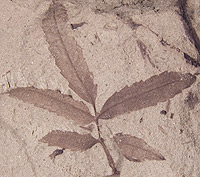5 Questions with . . . Dana Royer

In this issue we ask 5 Questions to…Dana Royer, assistant professor of earth and environmental sciences, who has a new study in the American Journal of Botany that examined flowering plant fossils in hopes of uncovering clues about the growth characteristics of some of these ancient angiosperms.
Q. Your study looks at the structure of fossil flowering plants, also known as angiosperms, from more than 100 million years ago. What were you hoping to discover?
A. Flowering plants are ubiquitous in most areas on Earth today. Over 90 percent of all plant species today are angiosperms. Given how important these plants are today, it is surprising how little we know about their origins. We sought to better understand the ecology of early angiosperms. In what kinds of environments did flowering plants rise to dominance? What was their growth strategy: were the slow-growing or fast-growing?
2. What is the basis for the theory that angiosperms from 140-100 million years ago were fast-growing?
A. It has been known for several decades that many of the earliest angiosperm fossils are found in river deposits. Plants growing today along river corridors are usually fast-growing. This is true not just for the weeds but also for the trees such as cottonwood. Surviving in river corridors can be difficult because they are associated with frequent disturbances such as seasonal flooding. Fast-growing, weedy, opportunistic plants do well in disturbed environments because they can establish themselves and produce seed quicker than most other plants. Most telling, angiosperms are the only group among seed plants that have a seed-to-seed time of less than a year. Our goal was to provide complementary evidence for the fast-growth hypothesis. Instead of focusing on sediments, we focused on the fossils themselves. Several years ago, I developed a method for reconstructing leaf mass per area from fossils. Leaf mass per area is a measure of leaf thickness or density. It turns out that leaf mass per area is linked to a large number of other leaf traits, including rate of photosynthesis. In a nutshell, fast-growing plants tend to produce thin, less dense leaves (low leaf mass per area) because such leaves are cheap and fast to make (think birch leaves). In contrast, slow-growing plants tend to produce long-lived leaves (think rhododendron leaves). It is beneficial for these plants to have thick, hearty leaves (high leaf mass per area) so that they can get a return on their investment. We reconstructed leaf mass per area as a window into growth strategy for 27 early angiosperm species.
strong>

Q. In basic terms, what findings did your study produce to support or discount that theory?
A. Overwhelmingly, our early angiosperm fossils have a low leaf mass per area. The distribution of leaf mass per area across our fossils is very similar to the distribution you find along river corridors today. Our data strongly support that early angiosperms employed a fast growth strategy.
Q. What are the similarities between the angiosperm samples you looked at and those of our own era?
A. Angiosperms today have a wide range of growth strategies. Certainly, many angiosperms have the capacity for extremely rapid growth. Bamboo, for example, can grow one meter in one day. But many angiosperms are slow-growing. In fact, flowering plants are often the dominant plant group in physically-stressed environments (for example, deserts) and nutrient-stressed environments (for example, bogs). We see angiosperms almost everywhere today, but the fossil record is most consistent with them rising to ecological dominance first in environments that selected for fast growth, then radiating from there into environments where slow growth was an advantage.
Q. What are the implications of your findings?
A. I think it is important to know the ecological history of such an important group of plants. Studying fossils is the most direct way to answer this question. Our study strongly supports the idea that the unrivalled capacity for fast growth observed today in many angiosperms was in place by no later than 110 million years ago and likely played an important role in their subsequent ecological success.

